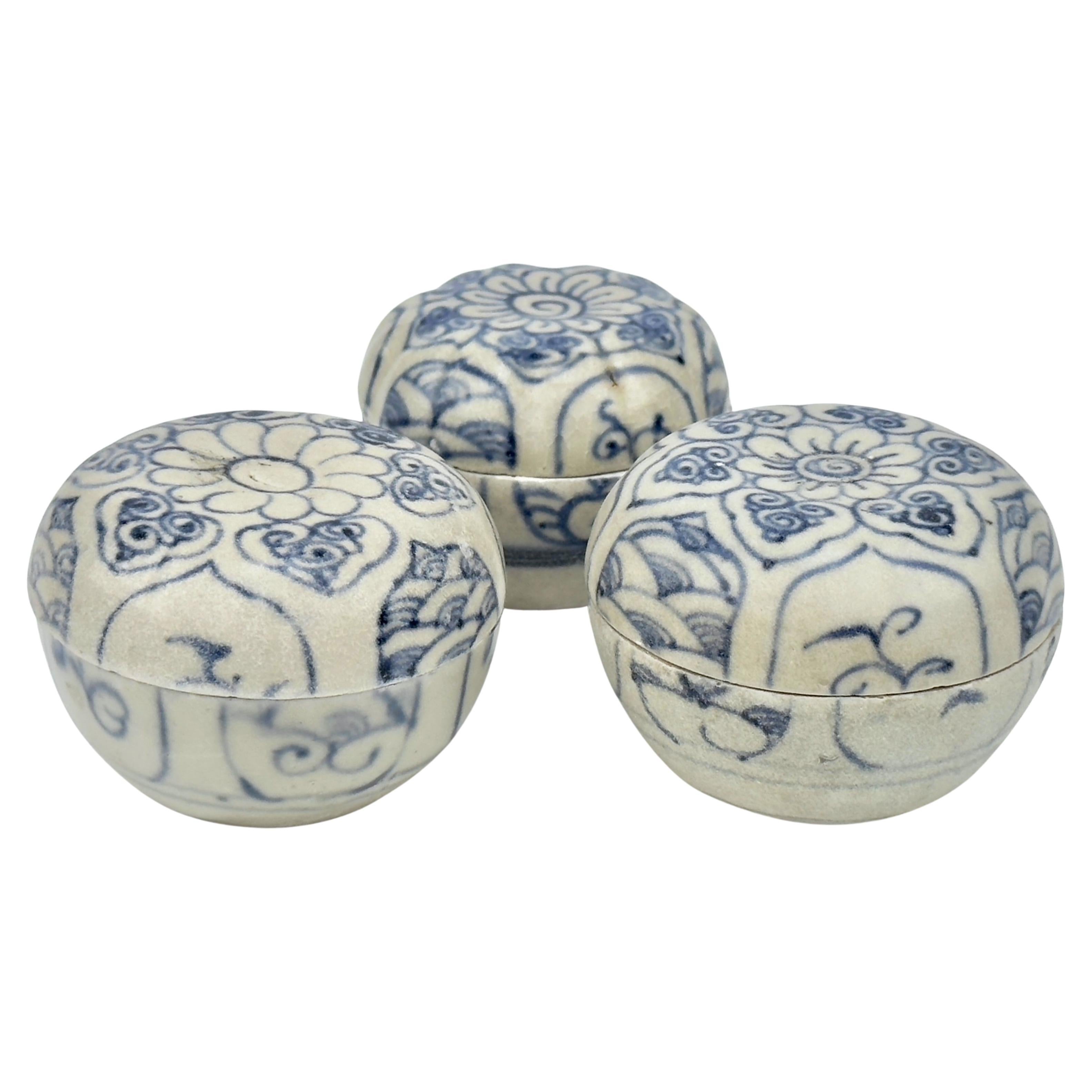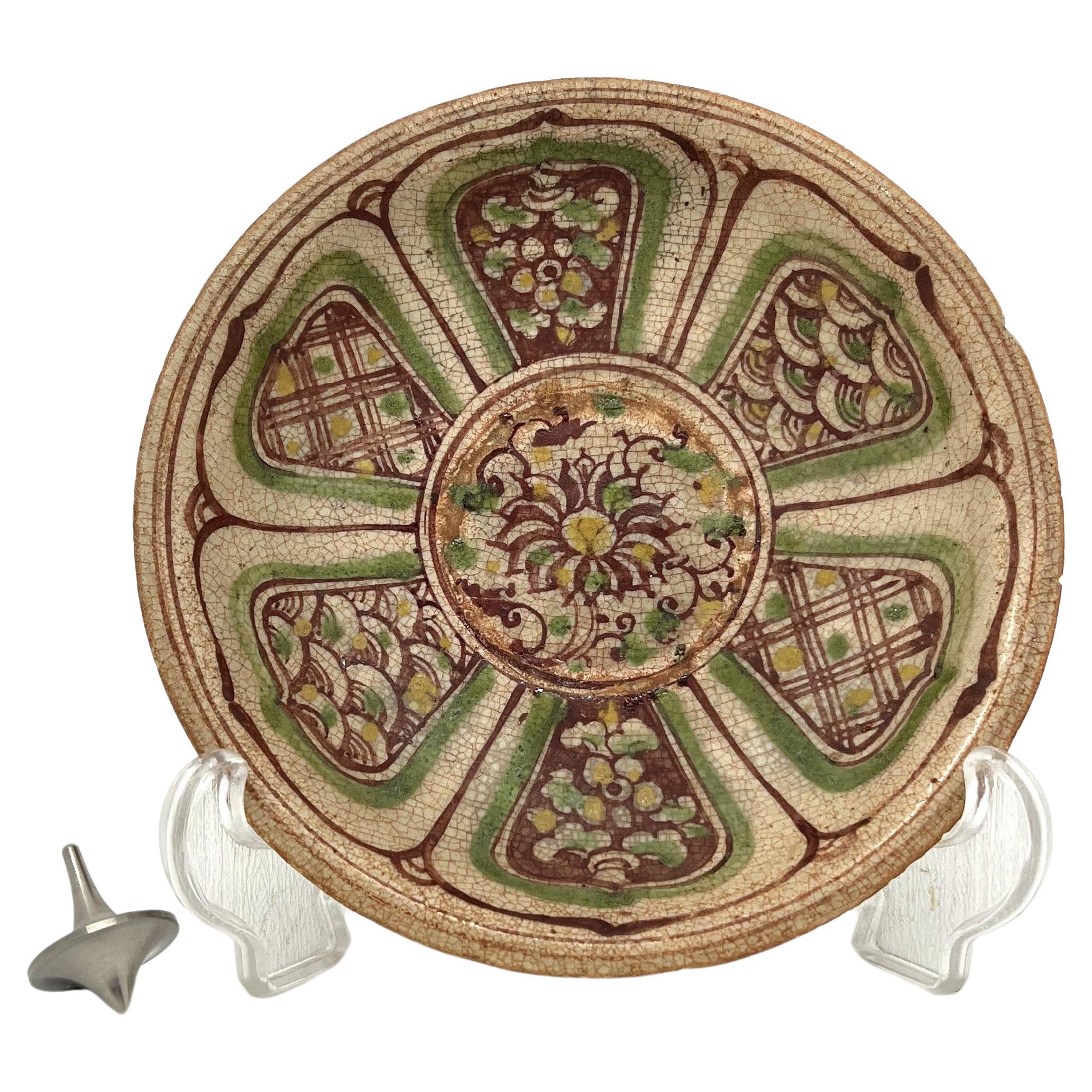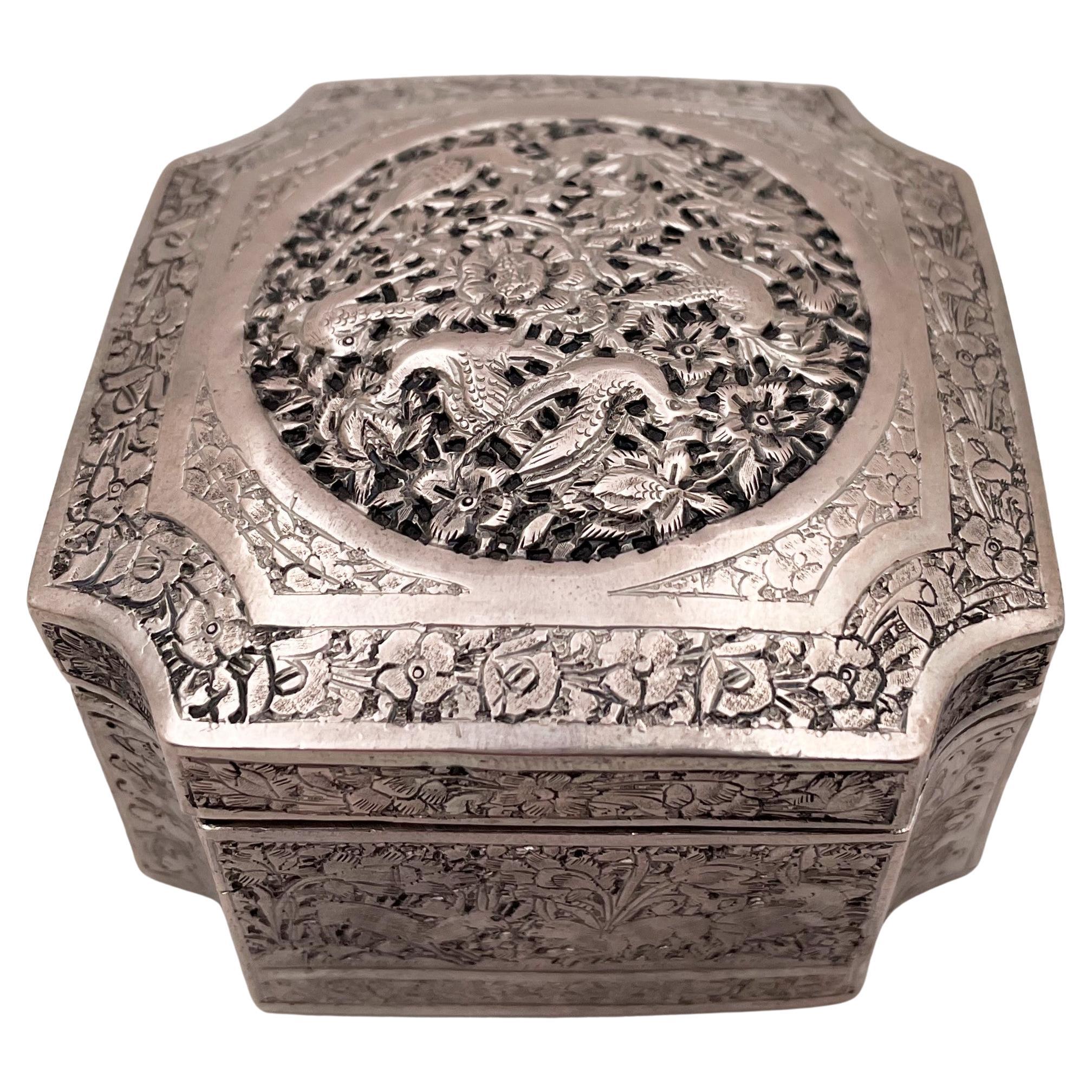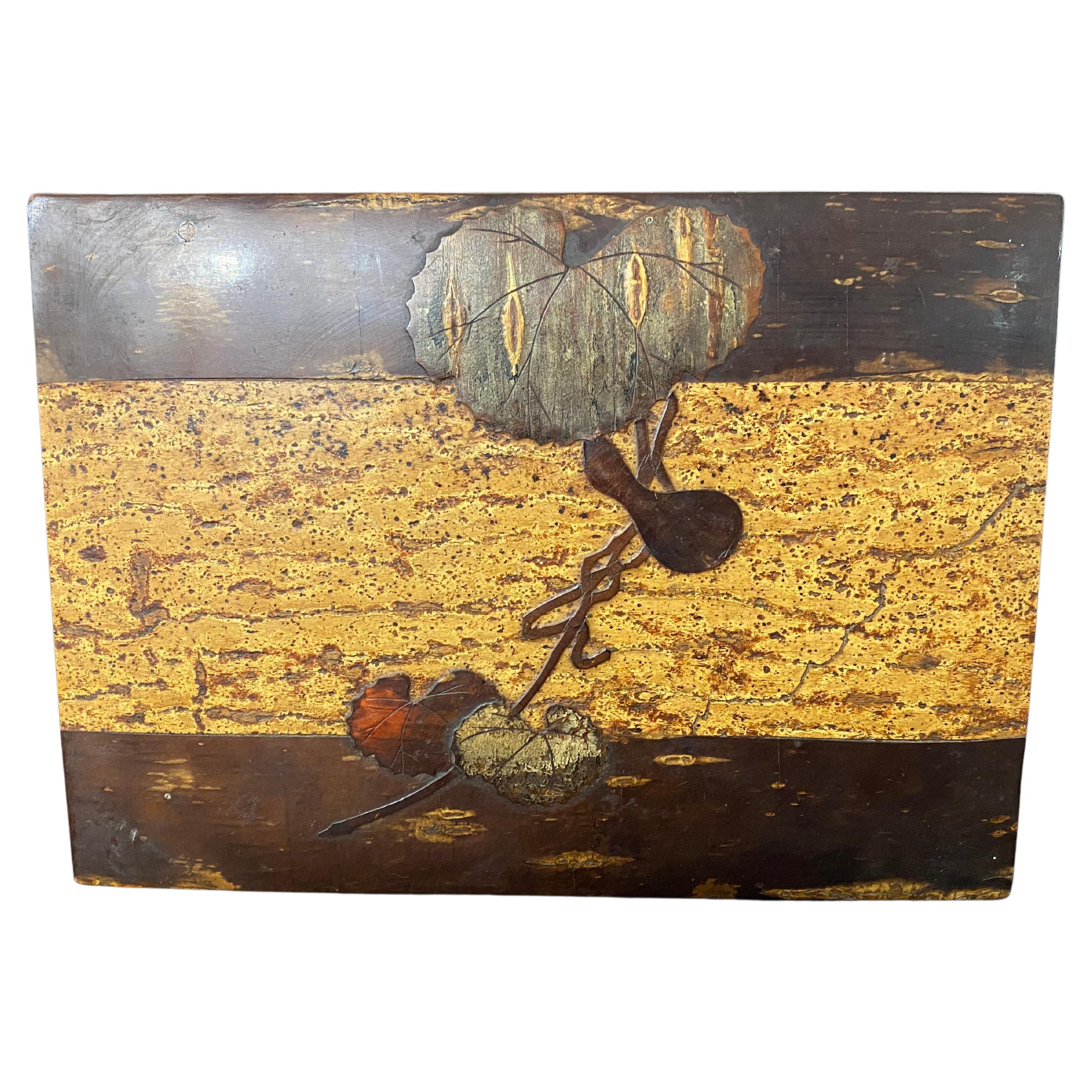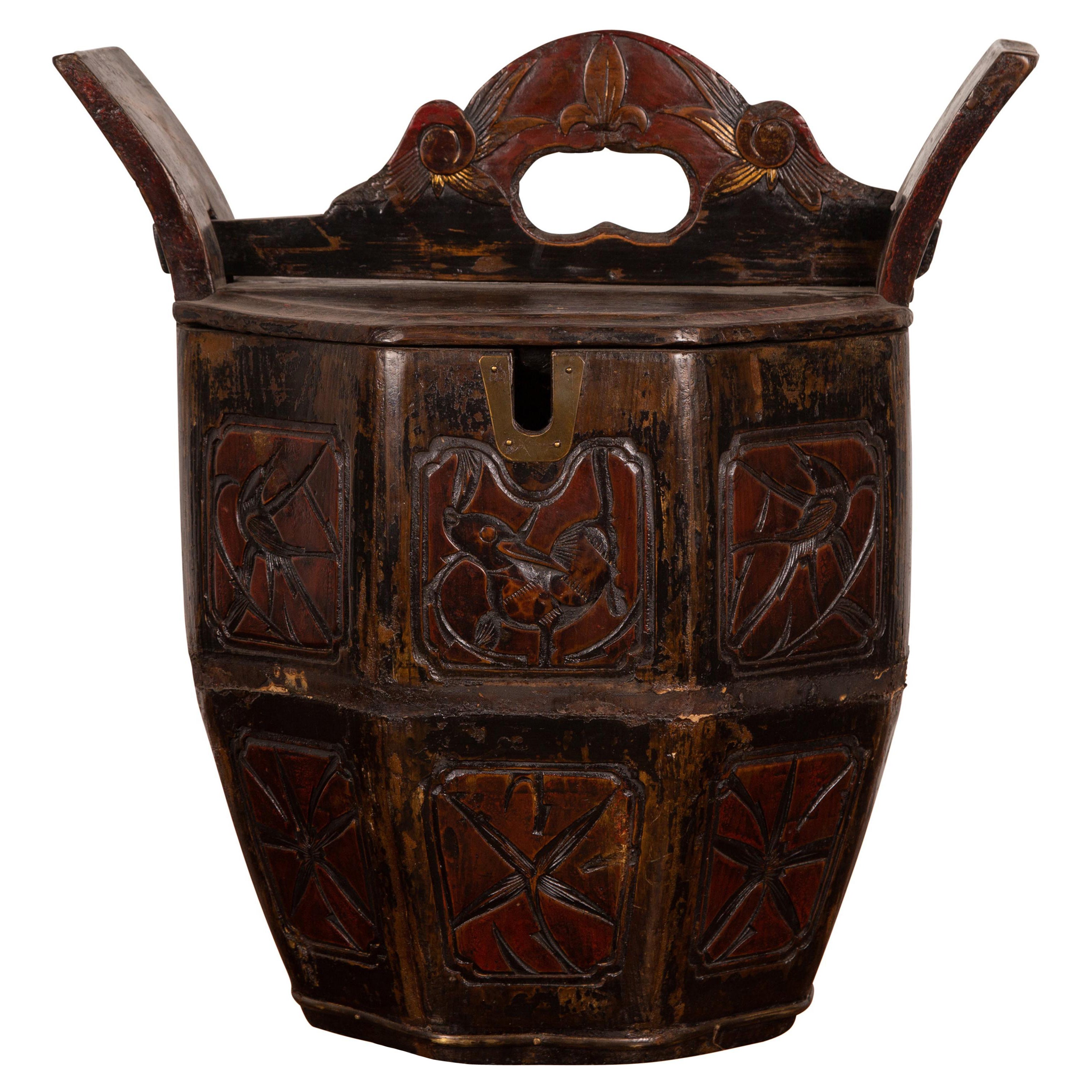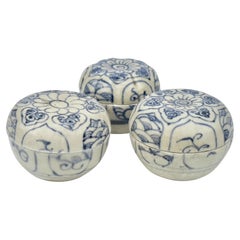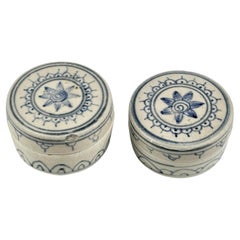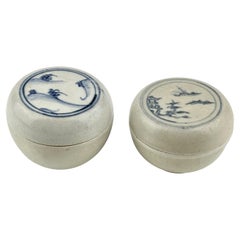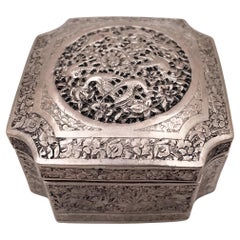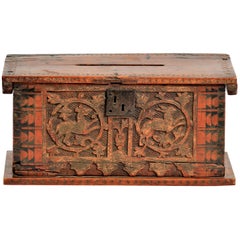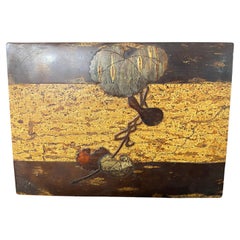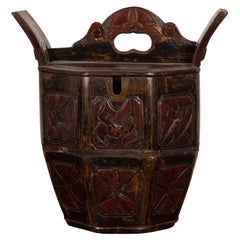Items Similar to Two Annamese Covered Boxes with Bird and Plant Motif, 15th century, Le Dynasty
Want more images or videos?
Request additional images or videos from the seller
1 of 13
Two Annamese Covered Boxes with Bird and Plant Motif, 15th century, Le Dynasty
About the Item
Vietnamese covered boxes with representative bird and plant designs. Both are made of cream-colored base and blue designs, typical of Annamese pottery. These shared characteristics highlight the traditional craftsmanship and aesthetic values of the Le Dynasty period.
Dates : 15th century Le Dynasty
Region : North Annam, Vietnam
Type : Covered box
Found/Acquired : Southeast Asia , South China Sea, Hoi An Ship
Dimension : Left - 5cm(Height) x 7cm(Diameter) / Right - 4.5cm(Height) x 6.5cm(Diameter)
Reference : Double checked with reference to the original catalogue
1) Butterfield Treasures Hoi An Hoard Auction Catalogs / San Francisco Butterfields 2000
2) Asian Ceramic Found along Maritime Silk Route / National Maritime Museum of Korea
3) Vietnamese Ceramics Miniatures / Catalogue of the exhibition in Zurich Sep 1989 Switzerland (Collection of Ulrich J. Beck)
* Vietnamese trade ceramics
Around the mid-14th century, Vietnam developed its ceramics production technology by producing blue and white porcelain, and began to export it overseas. During this period, China Ming Dynasty implemented a policy of lifting the ban from 1371 to 1657 and restricted foreign trade. This served as a good opportunity in the trade history of Vietnamese ceramics, and ceramic exports boomed from the late 15th to the 16th century, expanding sales channels not only to Southeast Asia but also to Japan, the Middle East, and several European countries.
During 15~16th century, Vietnam's international trade policy became much more liberal than in the past. In northern Vietnam, commerce became more active as markets were formed around ports, riverine ports, and handicraft villages. This led to the emergence of many large commercial centers such as Phố Hiến, Thăng Long and Hội An.
Through this, Vietnam's international trade and economy also grew significantly. In the above commercial area, stores of European merchants from the Netherlands, England, France, and Portugal were opened and operated. Merchants from many countries around the world entered Vietnam and engaged in intermediate trade.
- Dimensions:Height: 1.97 in (5 cm)Diameter: 2.76 in (7 cm)
- Materials and Techniques:
- Place of Origin:
- Period:
- Date of Manufacture:15th century
- Condition:Minor fading.
- Seller Location:seoul, KR
- Reference Number:1stDibs: LU9577240398202
About the Seller
4.8
Gold Seller
Premium sellers maintaining a 4.3+ rating and 24-hour response times
Established in 1999
1stDibs seller since 2023
35 sales on 1stDibs
Typical response time: 1 hour
- ShippingRetrieving quote...Shipping from: seoul, Korea South
- Return Policy
Authenticity Guarantee
In the unlikely event there’s an issue with an item’s authenticity, contact us within 1 year for a full refund. DetailsMoney-Back Guarantee
If your item is not as described, is damaged in transit, or does not arrive, contact us within 7 days for a full refund. Details24-Hour Cancellation
You have a 24-hour grace period in which to reconsider your purchase, with no questions asked.Vetted Professional Sellers
Our world-class sellers must adhere to strict standards for service and quality, maintaining the integrity of our listings.Price-Match Guarantee
If you find that a seller listed the same item for a lower price elsewhere, we’ll match it.Trusted Global Delivery
Our best-in-class carrier network provides specialized shipping options worldwide, including custom delivery.More From This Seller
View AllThree Annamese Small Lidded Boxes with flower design, 15th century, Le Dynasty
Located in seoul, KR
These are three small lidded boxes from the Vietnamese period, specifically from the 15th century during the Le Dynasty. Each box features intricate floral designs in blue on a white...
Category
Antique 15th Century and Earlier Vietnamese Decorative Boxes
Materials
Ceramic, Stoneware
Two Annamese Miniature Covered Boxes with Flower, 15th century, Le Dynasty
Located in seoul, KR
Vietnamese covered boxes with star like flower designs. Both are made of cream-colored base and blue designs, typical of Annamese stoneware.
Dates : 15th century Le Dynasty
Region :...
Category
Antique 15th Century and Earlier Vietnamese Antiquities
Materials
Stoneware
$1,170 Sale Price / set
35% Off
Two Annamese Miniature Covered Boxes with Scenary Motif, 15th century, Le Dynast
Located in seoul, KR
Vietnamese covered boxes with representative scenary designs. Both are made of cream-colored base and blue designs, typical of Annamese pottery. These shared characteristics highligh...
Category
Antique 15th Century and Earlier Vietnamese Ming Antiquities
Materials
Stoneware
$1,033 Sale Price / set
35% Off
Two Annamese Miniature Kettle, 15th century, Le Dynasty
Located in seoul, KR
These 15th-century Le Dynasty ceramic vessels from northern Vietnam feature distinct designs. One is beige with faint blue floral patterns, a rounded body, and an elongated spout. Th...
Category
Antique 15th Century and Earlier Vietnamese Antiquities
Materials
Ceramic
$903 Sale Price / set
35% Off
Two Annamese Small Yuhuchunping, 15th century, Le Dynasty
Located in seoul, KR
These 15th-century Annamese ceramics from Le dynasty, are notable for their rarity and refined design. The Yuhuchunping vases, with their elegant pear-shaped bodies and delicate blue...
Category
Antique 15th Century and Earlier Vietnamese Ming Antiquities
Materials
Ceramic, Stoneware
$1,560 Sale Price / set
34% Off
Two Pair of Annamese Porcelain Crab Boxes, 15th century, Le Dynasty
Located in seoul, KR
Vietnamese stoneware crab boxes. Light blue glaze. This is one of the representative types of miniature works of Hoi An ships.
Dates : 15th century Le Dyn...
Category
Antique 15th Century and Earlier Vietnamese Antiquities
Materials
Ceramic, Porcelain
$1,953 Sale Price
30% Off
You May Also Like
Chinese Silver Box with Bird and Floral Motifs
Located in New York, NY
Chinese silver box, with an intricate design showcasing birds, floral, and other natural motifs, measuring 2 7/8'' by 2 7/8'' by 1 7/8'' in height.
Please feel free to ask us any q...
Category
Early 20th Century Chinese Decorative Boxes
Materials
Silver
Very Rare Casket Minnekästchen or Box, Germany or Italy, 15th Century
Located in Beuzevillette, FR
Wooden coffret, call minnekästchen, engraved with a dog, a hare and foliage with
polychromy remains. During the Middle Age, the hare is a symbol of fertility, joy and represents the Christ...
Category
Antique 15th Century and Earlier European Gothic Decorative Boxes
Materials
Iron
Japanese Box with Plant Design 20th Century
Located in Beuzevillette, FR
Charming Japanese box from the early 20th century. The wood is old and nicely inlaid on the lid. The lid is inlaid with different pieces of wood forming a...
Category
20th Century Japanese Decorative Boxes
Materials
Wood
Late Qing Dynasty Wedding Box with Carved Handle, Animals and Foliage Motifs
Located in Yonkers, NY
A late Qing Dynasty period wedding box from the early 20th century, this piece exudes charm with its traditional design and intricate carvings. The box features an appealing hexagona...
Category
Early 20th Century Chinese Decorative Boxes
Materials
Wood
A Meiji period moriage cloisonné box and cover with two carp
Located in Lymington, Hampshire
A Meiji period moriage cloisonné box and cover with two carp, the rectangular box worked in coloured enamels in standard, moriage (raised) and musen (wireless) cloisonné with one gre...
Category
Antique 19th Century Japanese Meiji Decorative Boxes
Materials
Ceramic
Embriachi workshop marquetry casket - Northern Italy, 15th century
Located in Bruxelles, BE
Embriachi workshop marquetry casket
Northern Italy, 15th century
Alla certosina inlays (bone, stained bone, pewter and wood)
H 28.2 x W 18 x D 14 cm
This beautiful casket of rectangular form is richly decorated with the characteristic geometric patterns of the Embriachi style.
The intricate geometric patterns are fashioned by juxtaposing lighter and darker pieces of wood, (colored) bone, horn and pewter. The lid and base are framed by a broad band of horn. When ivory became scarce in Europe due to disrupted trade routes, bone was substituted.
The attention to Symmetry and balance created an harmonious visual effect
Enhancing the overall aesthetic appeal of the casket.
The application of geometrical motifs is in Italy known as marquetry ‘alla Certosina’, named after the Certosina Church in Pavia with its famous altarpiece decorated in this way. This is ‘intarsia technique’, a term derived from the Arabic 'tarsi', which means ‘incrustation' recalling ancient mosaics made from various materials.
These geometric elements not only enhance the aesthetic appeal of the caskets but also demonstrate the versatility and skill of the artisans in creating multifaceted works of art.
‘Alla Certosina’ became famous through the Northern Italian Embriachi family who achieved a particularly high standard in working in this technique. Venice in particular was known for the production of these luxurious boxes. The caskets, hexagonal or rectangular, surmounted by a lid decorated in several registers constitute the secular, albeit equally renowned component of the workshop’s production, in addition to mirror frames and various everyday objects.
The method of fabrication of those objects was based on two concepts that underlay pre-industrial production: standardization and modularity, thanks to a distribution of skills according to the different phases of fabrication.
even the realization of the marquetry motifs (in the form of ingots from which portions of the desired size were cut) were therefore entrusted to various specialized craftsmen, as were the assembly phase.
Today better known thanks to the extensive research work recently carried out by Michele Tomasi, this workshop owes its name to its founder and owner, the Florentine Baldassare Ubriachi (or degli Embriachi), a merchant and banker established in the Tuscan capital before he settled in Venice in 1395. Together with sculptor Giovanni di Jacopo, who directed the workshop, from the last years of the fourteenth century, Baldassare oversaw a production that was truly original, and still easily recognizable today, comprising monumental altarpieces and various objects, primarily triptychs and caskets.
The precise location of the workshop is unknown, except that it originated in Florence and in ca. 1431 there was apparently a workshop in Venice, in the area of S Luca. They employed local workers specializing in 'certosina' (inlay of stained woods, bone and horn), and the workshop produced items carved in bone (usually horse or ox) with wood and bone marquetry.
The geometric decoration of Embriachi caskets reflects the artistic complexity and attention to detail that characterized their work.
this inlaid casket is a testament to the skill and artistry of the Embriachi family and serves as a stunning example of the decorative arts of the late Middle Ages.
Related Literature :
E. Berger, Prunk-Kassetten: Europäischen Meisterwerke aus acht Jahrhunderten / Ornamental Caskets...
Category
Antique 15th Century and Earlier Italian Renaissance Decorative Boxes
Materials
Pewter
$19,778 Sale Price
22% Off
Free Shipping
Recently Viewed
View AllMore Ways To Browse
15th Century Europe
Antique Furniture San Francisco
Maritime Objects
Ceramic With Bird Motif
Merchant East
Ming Dynasty Bedroom Furniture
Ceramic Birds Chinese
Chinese Glazed Birds
Korean Stoneware
Antique Handicrafts
Stoneware Bird
Ceramic Blue Glazed Bird
Japanese Ceramic Birds
Portuguese 16th
White Porcelain French Bird
Antique Japanese Stoneware
Korea Box
Ming Dynasty Silk
